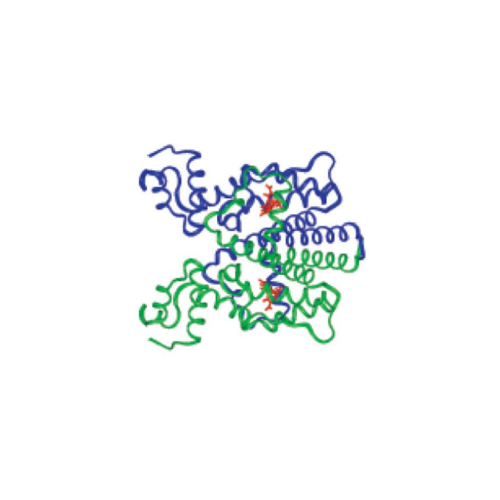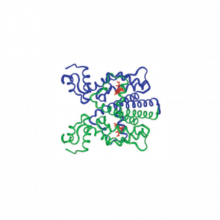
Anti-Tet-Repressor Antibody
Our set of polyclonal and monoclonal Anti-Tet Repressor (TetR) antibodies, manufactured by MoBiTec, possess excellent binding properties and have been successfully tested for use in ELISA, western blot and immunofluorescence assays.
The tetracycline regulatory system is widely used for selective target gene regulation in eukaryotic cells. These antibodies target the Tet-Repressor protein (TetR-B). TetR(B) has a length of 207 amino acids and a mass of 23,355 Da. The immunogen is TetR-tetO (Accession no. P04483).
Three antibodies are offered:
- TET01 - rabbit polyclonal antibody; can be used in ELISA, western blot and immunofluorescence.
- TET02 - optimized mix of two different epitope-specific monoclonal mouse antibodies.
- TET03 - single monoclonal mouse antibody; ideal for immunofluorescence microscopy.
TETR1, a purified 23 kDa Tet-Repressor (B) protein from E. coli transposon Tn10, is available as a positive control.
| TET01 | TET02 | TET03 | |
| Type | Rabbit polyclonal IgG | Monoclonal IgG1, K mix | Monoclonal IgG1, K |
| Immunogen | TetR(B)-tetO | TetR(B)-tetO | TetR(B)-tetO |
| Purification | Affinity purified via Protein G columns | Affinity purified via Protein A or G columns | Affinity purified via Protein A or G columns |
| Epitope | -- | TetR(B): Amino acid #84-98, Amino acid #26-53 | TetR(B): Amino acid #37-44 |
| Reconstitution In: | 200µl distilled water | 100µl distilled water | 100µl distilled water |
| Working Dilution for Immunofluorescence | n.d. | n.d. | n.d. |
| Working Dilution for Western Blots and ELISA | 1:1000 | 1:500 - 1:2000 | 1:1000 |
| Detection Limit for ELISA | 0.2 ng | 20-50 pg | n.d. |
| Detection Limit for Western Blot | 0.8 ng | 0.8 - 1.0 ng | 5 ng |
- Markusic et al., Nucleic Acids Res., Apr 2005; 33(6): e63
- Benabdellah et al., PLoS One. 2011;6(8):e23734
- Anders et al., Transgenic Res., Oct 2012, 21(5):1099-1107
- arXiv:1212.5109 [q-bio.MN] (2012)
- Prime tool for studying tet regulatory systems in eukaryotic cells
- Suited for ELISA, western blots and immunofluorescence (for cells only, not for tissues or tissue slices)
- Excellent binding properties
- Western blotting
- ELISA
- Immunofluorescence
- Detection of Tet-Repressor (TetR)
- Detection of Tet-Repressor fusion protein (TetR-Fusion)
- Detection of tetracycline responsive transactivator (tTA)
- Detection of reverse tetracycline responsive transactivator (rtTA) such as rtTA-S or rtTA-M
| Cat# | Description | Quantity |
| TET01 | Anti-Tet-Repressor, Polyclonal Rabbit, Lyophilized | 3mg |
| TET02 | Anti-Tet-Repressor, Monoclonal IgG1, Mix, Lyophilized | 1mg |
| TET03 | Anti-Tet-Repressor, Monoclonal IgG1, Lyophilized | 50µg |
| TETR1 | TET-Repressor Protein, Positive Control | 1µg |
- Pook E, Grimm S, Bonin A, Winkler T, Hillen W.(1998): Affinities of mAbs to Tet repressor complexed with operator or tetracycline suggest conformational changes associated with induction. Eur J Biochem. 1998 Dec 15;258(3):915-22.
- Hillen W, Berens C.(1994): Mechanisms underlying expression of Tn10 encoded tetracycline resistance. Annu Rev Microbiol. 1994;48:345-69.
- Gatz C.(1995): Novel inducible/repressible gene expression systems. Methods Cell Biol. 1995;50:411-24.
- Mayford M, Bach ME, Huang YY, Wang L, Hawkins RD, Kandel ER.(1996): Control of memory formation through regulated expression of a CaMKII transgene. Science. 1996 Dec 6;274(5293):1678-83.
- Hwang JJ, Scuric Z, Anderson WF. (1996): Novel retroviral vector transferring a suicide gene and a selectable marker gene with enhanced gene expression by using a tetracycline-responsive expression system. J Virol. 1996 Nov;70(11):8138-41.
- Gossen M, Freundlieb S, Bender G, Muller G, Hillen W, Bujard H. (1996): Transcriptional activation by tetracyclines in mammalian cells. Science. 1995 Jun 23;268(5218):1766-9.
- Hinrichs W, Kisker C, Duvel M, Muller A, Tovar K, Hillen W, Saenger W (1994): Structure of the Tet repressor-tetracycline complex and regulation of antibiotic resistance. Science. 1994 Apr 15;264(5157):418-20.
References with Tet-Repressor (TetR) Antibodies
- Marti F, Xu CW, Selvakumar A, Brent R, Dupont B, King PD. (1998): LCK-phosphorylated human killer cell-inhibitory receptors recruit and activate phosphatidylinositol 3-kinase. Proc Natl Acad Sci U S A. 1998 Sep 29;95(20):11810-5.
- Freundlieb S, Schirra-Muller C, Bujard H.(1999): A tetracycline controlled activation/repression system with increased potential for gene transfer into mammalian cells. J Gene Med. 1999 Jan-Feb;1(1):4-12.
- Urlinger S, Baron U, Thellmann M, Hasan MT, Bujard H, Hillen W. (2000): Exploring the sequence space for tetracycline-dependent transcriptional activators: novel mutations yield expanded range and sensitivity. Proc Natl Acad Sci U S A. 2000 Jul 5;97(14):7963-8.
- Meissner M, Brecht S, Bujard H, Soldati D. (2001): Modulation of myosin A expression by a newly established tetracycline repressor-based inducible system in Toxoplasma gondii. Nucleic Acids Res. 2001 Nov 15;29(22):E115.
- Lorenz P, Koczan D, Thiesen HJ (2001): Transcriptional repression mediated by the KRAB domain of the human C2H2 zinc finger protein Kox1/ZNF10 does not require histone deacetylation. Biol Chem. 2001 Apr;382(4):637-44.
- Fiedler M, Skerra A (2001): proBA complementation of an auxotrophic E. coli strain improves plasmid stability and expression yield during fermenter production of a recombinant antibody fragment. Gene. 2001 Aug 22;274(1-2):111-8.
- Stebbins MJ, Urlinger S, Byrne G, Bello B, Hillen W, Yin JC (2001): Tetracycline-inducible systems for Drosophila. Proc Natl Acad Sci U S A. 2001 Sep 11;98(19):10775-80. Epub 2001 Aug 21.
- David KM, Perrot-Rechenmann C (2001): Characterization of a tobacco Bright Yellow 2 cell line expressing the tetracycline repressor at a high level for strict regulation of transgene expression. Plant Physiol. 2001 Apr;125(4):1548-53.
- Reeves PJ, Callewaert N, Contreras R, Khorana HG (2002): Structure and function in rhodopsin: high-level expression of rhodopsin with restricted and homogeneous N-glycosylation by a tetracycline-inducible N-acetylglucosaminyltransferase I-negative HEK293S stable mammalian cell line. Proc Natl Acad Sci U S A. 2002 Oct 15;99(21):13419-24. Epub 2002 Oct 7.
- Kamper MR, Gohla G, Schluter G (2002): A novel positive tetracycline-dependent transactivator (rtTA) variant with reduced background activity and enhanced activation potential. FEBS Lett. 2002 Apr 24;517(1-3):115-20.
- Krueger C, Berens C, Schmidt A, Schnappinger D, Hillen W (2003): Single-chain Tet transregulators. Nucleic Acids Res. 2003 Jun 15;31(12):3050-6.
- Czauderna F, Santel A, Hinz M, Fechtner M, Durieux B, Fisch G, Leenders F, Arnold W, Giese K, Klippel A, Kaufmann J (2003): Inducible shRNA expression for application in a prostate cancer mouse model. Nucleic Acids Res. 2003 Nov 1;31(21):e127.
- Leenders F, Mopert K, Schmiedeknecht A, Santel A, Czauderna F, Aleku M, Penschuck S, Dames S, Sternberger M, Rohl T, Wellmann A, Arnold W, Giese K, Kaufmann J, Klippel A (2004): PKN3 is required for malignant prostate cell growth downstream of activated PI 3-kinase. EMBO J. 2004 Aug 18;23(16):3303-13. Epub 2004 Jul 29.
- Das AT, Zhou X, Vink M, Klaver B, Verhoef K, Marzio G, Berkhout B (2004): Viral evolution as a tool to improve the tetracycline-regulated gene expression system. J Biol Chem. 2004 Apr 30;279(18):18776-82. Epub 2004 Feb 2.
- Rupp B, Ruzsics Z, Sacher T, Koszinowski UH (2005): Conditional cytomegalovirus replication in vitro and in vivo. J Virol. 2005 Jan;79(1):486-94.
- Markusic D, Oude-Elferink R, Das AT, Berkhout B, Seppen J (2005): Comparison of single regulated lentiviral vectors with rtTA expression driven by an autoregulatory loop or a constitutive promoter. Nucleic Acids Res. 2005 Apr 4;33(6):e63.
- Osada M, Park HL, Nagakawa Y, Yamashita K, Fomenkov A, Kim MS, Wu G, Nomoto S, Trink B, Sidransky D (2005): Differential recognition of response elements determines target gene specificity for p53 and p63. Mol Cell Biol. 2005 Jul;25(14):6077-89.
- Ito T, Hashimoto Y, Tanaka E, Kan T, Tsunoda S, Sato F, Higashiyama M, Okumura T, Shimada Y (2006): An inducible short-hairpin RNA vector against osteopontin reduces metastatic potential of human esophageal squamous cell carcinoma in vitro and in vivo. Clin Cancer Res. 2006 Feb 15;12(4):1308-16.
- Lukes J, Paris Z, Regmi S, Breitling R, Mureev S, Kushnir S, Pyatkov K, Jirku M, Alexandrov KA (2006): Translational initiation in Leishmania tarentolae and Phytomonas serpens (Kinetoplastida) is strongly influenced by pre-ATG triplet and its 5' sequence context. Mol Biochem Parasitol. 2006 Aug;148(2):125-32. Epub 2006 Apr 18.
- Cai D, Vaughan M. Latham, Jr., Xinxin Zhang, and Geoffrey I. Shapiro (2006): Combined Depletion of Cell Cycle and Transcriptional Cyclin-Dependent Kinase Activities Induces Apoptosis in Cancer Cells. Cancer Res., Sep 2006; 66: 9270 - 9280.
- Bulliard Y, Wiznerowicz M, Barde I, Trono D (2006): KRAB Can Repress Lentivirus Proviral Transcription Independently of Integration Site J. Biol. Chem., Nov 2006; 281: 35742 - 35746.
- Palona I, Namba H, Mitsutake N, Starenki D, Podtcheko A, Sedliarou I, Ohtsuru A, Saenko V, Nagayama Y, Umezawa K, Yamashita S (2006): BRAFV600E promotes invasiveness of thyroid cancer cells through nuclear factor kappaB activation. Endocrinology, Dec 2006; 147: 5699 - 5707.
- Seibler J, Kleinridders A, Küter-Luks B, Niehaves S, Brüning JC, Schwenk F (2007): Reversible gene knockdown in mice using a tight, inducible shRNA expression system. Nucleic Acids Res., Apr 2007; 35: e54.
- Carrillo J, García-Aragoncillo E, Azorín D, Agra N, Sastre A, González-Mediero I, García-Miguel P, Pestaña A, Gallego S, Segura D, Alonso J (2007): Cholecystokinin Down-Regulation by RNA Interference Impairs Ewing Tumor Growth Clin. Cancer Res., Apr 2007; 13: 2429 - 2440.
- Wegmüller D, Raineri I, Gross B, Oakeley EJ, Moroni C (2007): A Cassette System to Study Embryonic Stem Cell Differentiation by Inducible RNA Interference. Stem Cells, May 2007; 25: 1178 - 1185.
- Weber A, Paschen SA, Heger K, Wilfling F, Frankenberg T, Bauerschmitt H, Seiffert BM, Kirschnek S, Wagner H, Häcker G (2007): BimS-induced apoptosis requires mitochondrial localization but not interaction with anti-apoptotic Bcl-2 proteins. J. Cell Biol., May 2007; 177: 625 - 636.
Boca Scientific is your premiere source for high-quality, innovative solutions for Cell Biology, Molecular Biology, Immunology, genetics and other lab products and reagents. We bring leading-edge products from our own-line and around the world to laboratories in the US and Canada. Our goal is to offer excellent solutions to drive research and discoveries backed by superior customer support.

